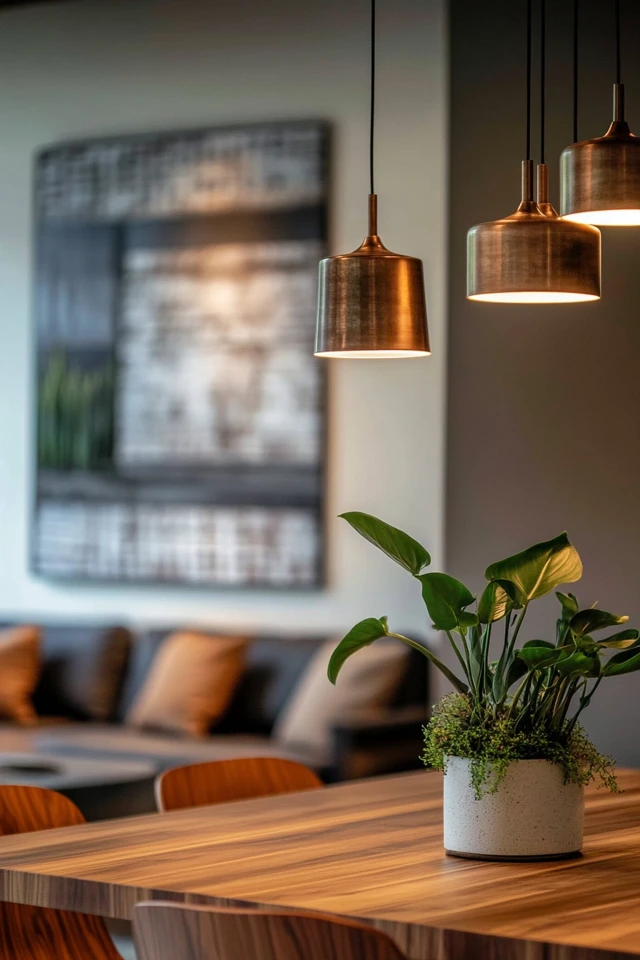Mid-century modern decor is celebrated for its clean lines, timeless furniture, and warm wood tones, while industrial design is known for its raw materials, rugged finishes, and utilitarian charm. Blending these two styles creates a unique aesthetic that’s both sleek and edgy, refined yet bold.
I’ve always loved the juxtaposition of the two styles. The first time I blended industrial touches into a mid-century space was during a loft redesign. The exposed brick walls and metal beams screamed industrial, but the client loved mid-century furniture. Combining vintage teak pieces with steel shelving and Edison bulb lighting brought harmony to the space. Now, it’s one of my favorite projects to date.
In this guide, I’ll show you how to incorporate subtle industrial elements into mid-century modern decor without overpowering the clean, warm aesthetic of mid-century design.
Why Industrial Touches Work With Mid-Century Modern
- Contrast: Industrial design’s raw materials contrast beautifully with the smooth finishes and natural wood tones of mid-century furniture.
- Balance: Industrial accents add ruggedness to the polished look of mid-century modern spaces.
- Timelessness: Both styles feature designs that prioritize function and durability, creating a cohesive blend.
- Neutral Palette: The earthy tones of industrial materials complement the warm, muted hues of mid-century modern decor.
1. Start With Industrial Lighting
Why It Works:
Lighting is a key feature in both styles, and industrial fixtures like exposed bulbs, steel pendants, and metal sconces pair beautifully with mid-century furnishings.
How to Incorporate It:
- Replace a mid-century pendant with an industrial chandelier featuring Edison bulbs.
- Add a metal swing-arm sconce above a mid-century nightstand or sofa.
- Use a matte black or aged brass floor lamp with an exposed bulb for a subtle industrial touch.
Pro Tip: Look for lighting with clean, simple lines to stay true to mid-century modern minimalism.
2. Incorporate Metal Furniture or Accents
Why It Works:
Industrial style is defined by its use of raw and durable materials, especially metal. Adding metal accents to a mid-century space creates an edgy, modern contrast.
How to Incorporate It:
- Pair a wooden mid-century dining table with metal dining chairs for a mixed-material look.
- Add a steel-framed coffee table or side table to complement a mid-century sofa.
- Use metal shelving units for a functional yet stylish storage solution.
Pro Tip: Stick to matte or brushed finishes (black, bronze, or aged steel) to maintain a subtle, cohesive look.
3. Mix Textures With Wood and Concrete
Why It Works:
Concrete is a hallmark of industrial design, and when paired with the warmth of mid-century wood tones, it creates a perfect balance of rugged and refined.
How to Incorporate It:
- Use a concrete planter or vase as a centerpiece on a mid-century credenza.
- Opt for a concrete-topped dining table with wooden legs.
- Add a small concrete side table to balance a mid-century armchair.
Pro Tip: Balance cold concrete with warm accents like a jute rug or woven textiles.
4. Add Exposed or Distressed Finishes
Why It Works:
Industrial design embraces imperfections, such as exposed brick, raw wood, and weathered metals, which add character and contrast to mid-century spaces.
How to Incorporate It:
- Highlight exposed brick walls or concrete beams if your space already has them.
- Add a reclaimed wood shelf with visible knots and grain for a subtle industrial vibe.
- Incorporate a distressed leather armchair or ottoman into your living room.
Pro Tip: Keep the rest of the space polished to let the industrial details stand out.
5. Use Rugged Industrial Hardware
Why It Works:
Industrial-style hardware is a small but impactful way to introduce an industrial edge to mid-century decor.
How to Incorporate It:
- Swap out cabinet handles and drawer pulls for matte black or brushed steel options.
- Add metal brackets to open shelving for an industrial touch.
- Use steel hooks or racks for functional storage in an entryway or kitchen.
Pro Tip: Look for minimalist hardware designs to maintain a streamlined aesthetic.
6. Layer Soft Industrial Fabrics
Why It Works:
Industrial spaces often feature utilitarian fabrics like canvas, leather, and wool, which pair beautifully with mid-century modern upholstery.
How to Incorporate It:
- Add a canvas or leather pillow to a mid-century sofa.
- Use a wool or woven throw blanket to soften a metal-framed chair.
- Incorporate a neutral-toned area rug with a subtle industrial pattern, like stripes or grids.
Pro Tip: Stick to muted tones like gray, beige, or navy for a cohesive look.
7. Introduce Industrial Decor Elements
Why It Works:
Small decor pieces allow you to experiment with industrial style without committing to larger changes.
How to Incorporate It:
- Use a vintage metal clock, like a train station-style wall clock, as a focal point.
- Add galvanized metal trays or baskets for storage.
- Display industrial-inspired artwork, such as abstract prints with geometric or mechanical motifs.
Pro Tip: Combine industrial decor with mid-century classics like ceramic vases or wooden bowls to keep the look balanced.
8. Play With a Neutral Color Palette
Why It Works:
Both mid-century modern and industrial styles share a love of neutral tones, which create a harmonious foundation for blending the two aesthetics.
How to Incorporate It:
- Start with a base of warm neutrals like beige, gray, and brown.
- Add black and white accents for a crisp, industrial edge.
- Use muted shades of green or blue to tie the palette together.
Pro Tip: Keep the walls neutral and let furniture and decor add depth and contrast.
9. Use Open Shelving With Industrial Flair
Why It Works:
Industrial design emphasizes functionality, and open shelving fits perfectly into mid-century spaces with its clean lines and practical appeal.
How to Incorporate It:
- Use metal-framed or pipe-style shelving in a kitchen or living room.
- Display mid-century ceramics, books, and plants on the shelves to soften the industrial look.
- Choose wood shelving with visible grain for a rugged, natural touch.
Pro Tip: Arrange items neatly to maintain the minimalist feel of mid-century design.
10. Add Statement Industrial Fixtures
Why It Works:
A single industrial statement piece can anchor a room while complementing mid-century elements.
How to Incorporate It:
- Install a large metal pendant light over a dining table or kitchen island.
- Use a bold, industrial-style mirror with a steel or black frame.
- Add a factory-inspired rolling cart as a side table or bar cart.
Pro Tip: Limit the number of statement pieces to one or two per room to avoid overwhelming the space.
Picture Gallery
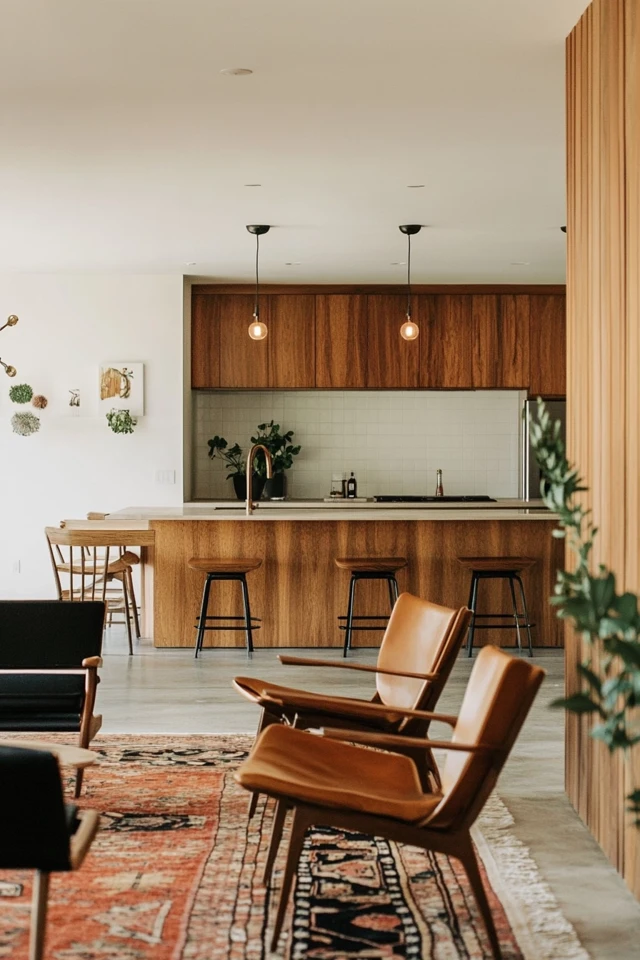
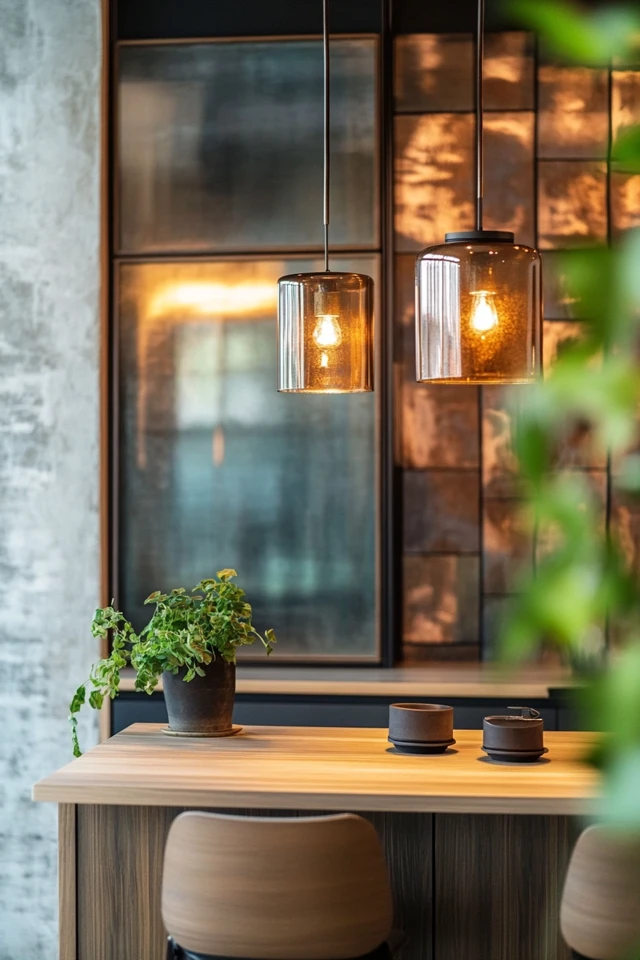
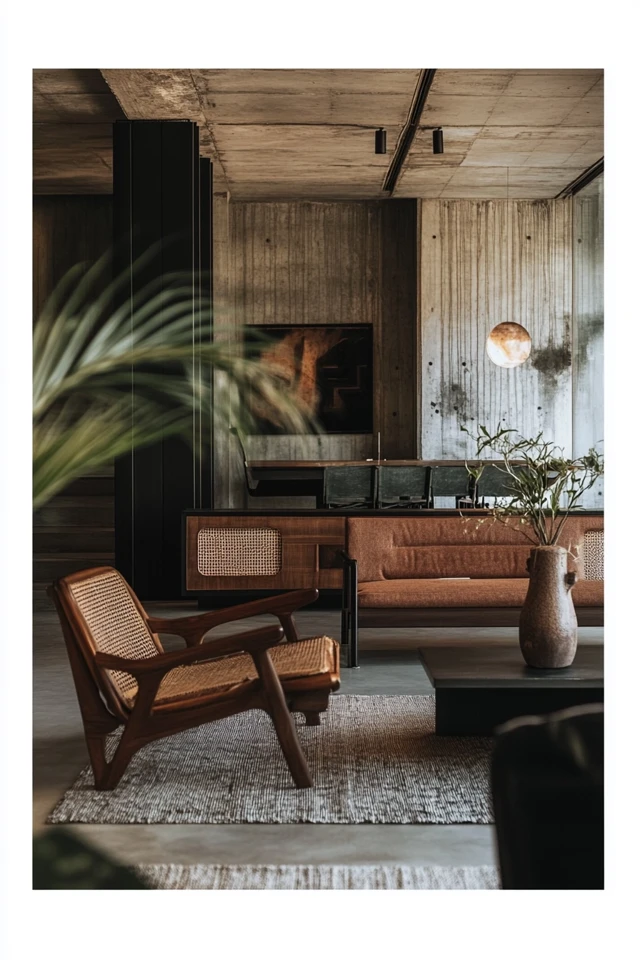
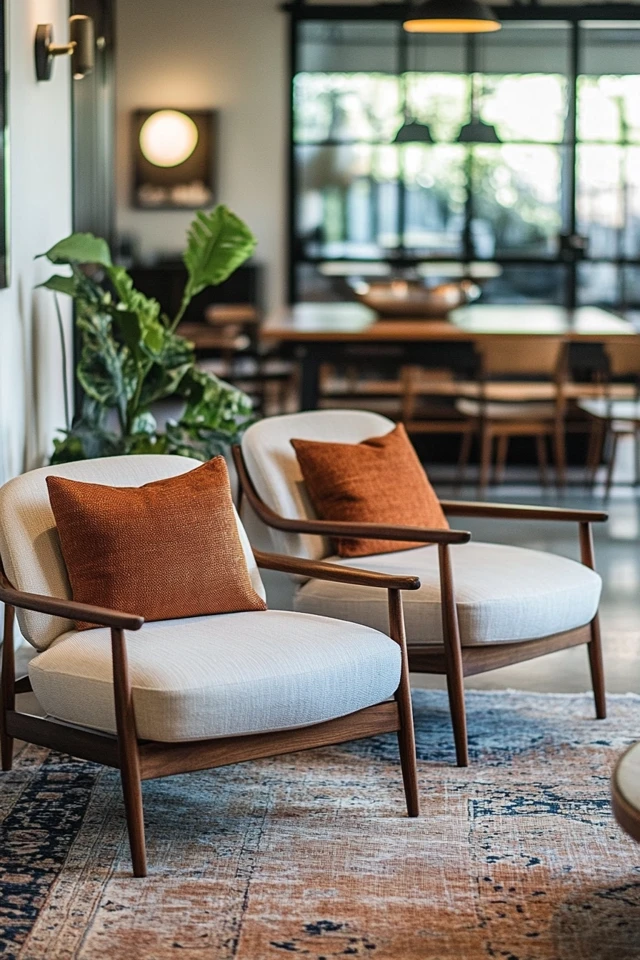

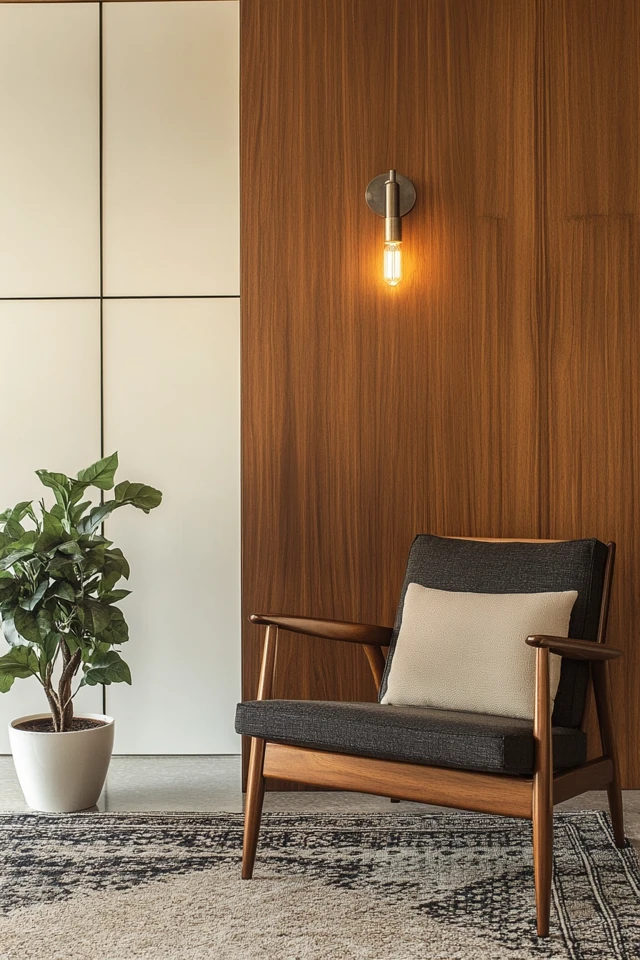
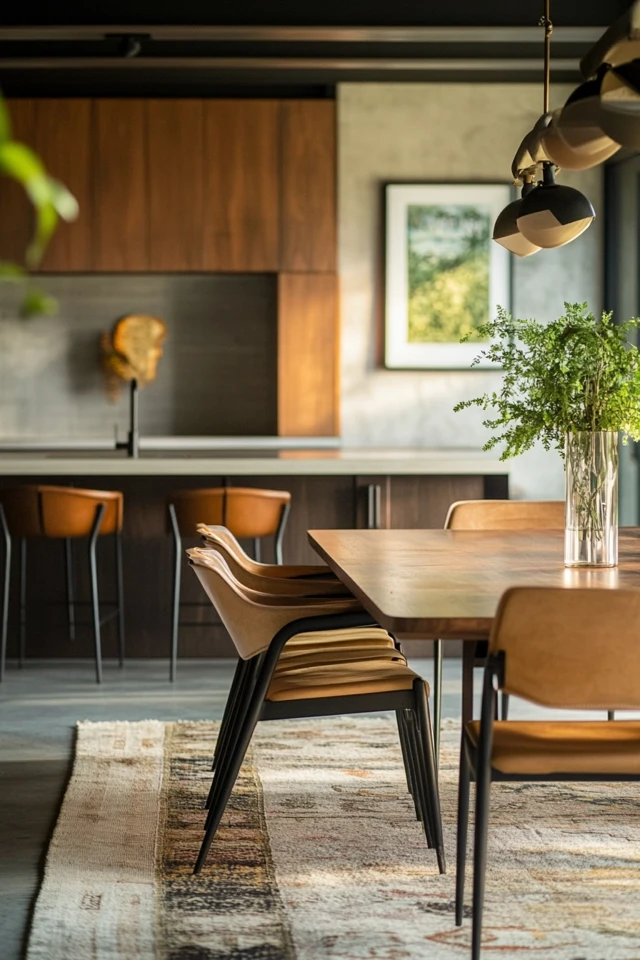
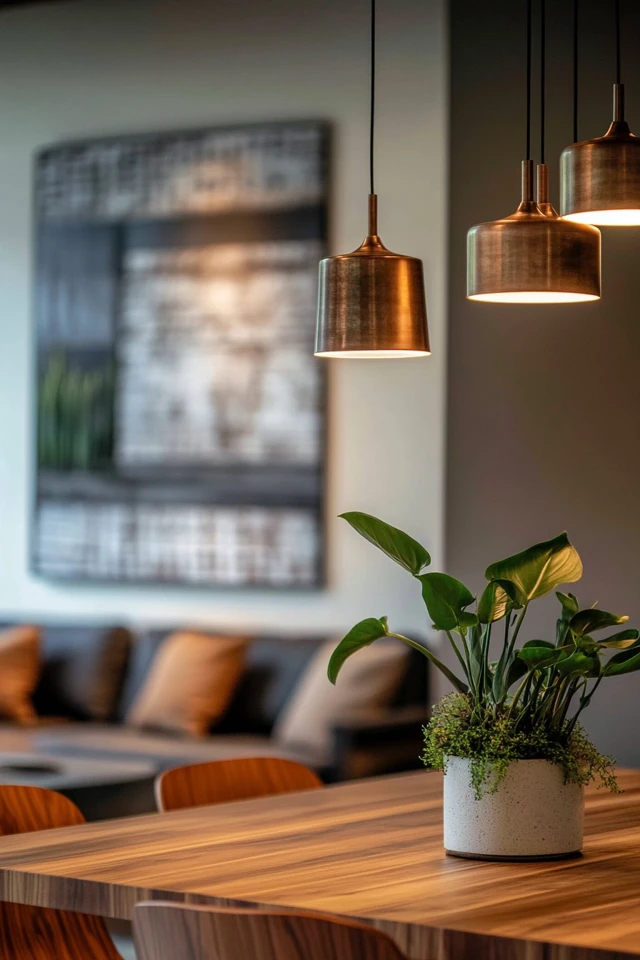
Conclusion
Combining mid-century modern and industrial styles creates a unique, balanced aesthetic that’s both polished and edgy. By incorporating subtle industrial touches like metal accents, rugged finishes, and utilitarian decor, you can enhance the timeless charm of mid-century spaces with a touch of urban sophistication.
The key is balance—too many industrial elements can overpower the clean simplicity of mid-century design, so choose pieces that complement rather than compete. Start small with lighting or decor, and build from there to create a harmonious blend of these two iconic styles.
FAQs
1. Can I mix mid-century modern and industrial styles in a small space?
Yes! Stick to subtle industrial touches like lighting, hardware, or decor to avoid overwhelming the room.
2. What materials should I focus on for industrial accents?
Focus on metal, concrete, exposed wood, and leather to achieve an industrial vibe.
3. Can I combine industrial and mid-century furniture?
Absolutely! Pair metal-framed furniture with classic mid-century wooden pieces for a balanced look.
4. How do I keep the space from feeling too cold?
Add warmth with textiles like wool throws, leather pillows, or area rugs. Greenery also softens the look.
5. Where can I find industrial-inspired decor to complement mid-century modern pieces?
Check out stores like West Elm, CB2, or Etsy for a mix of industrial and mid-century modern decor. Flea markets and vintage shops are also great for unique finds.

